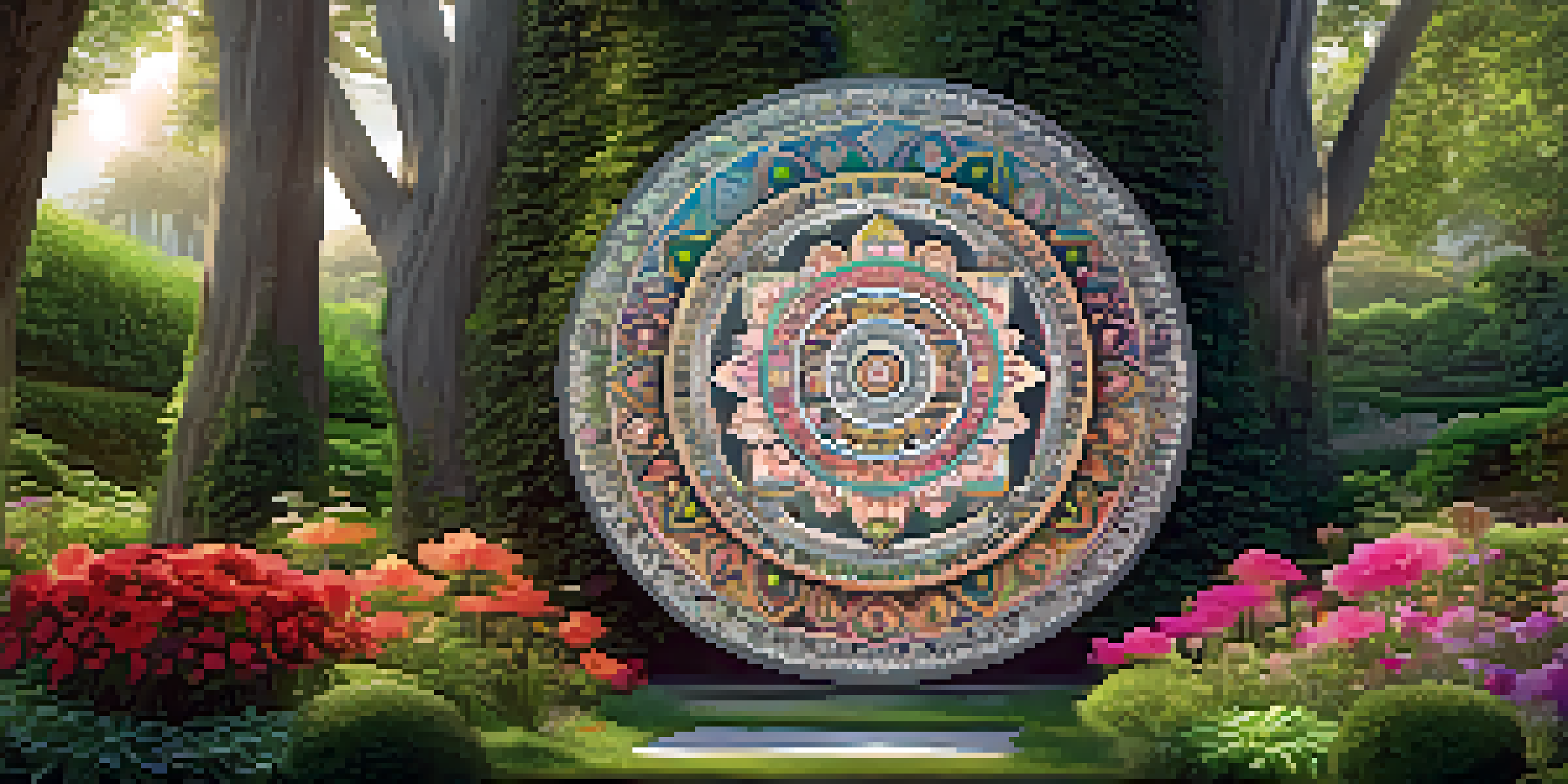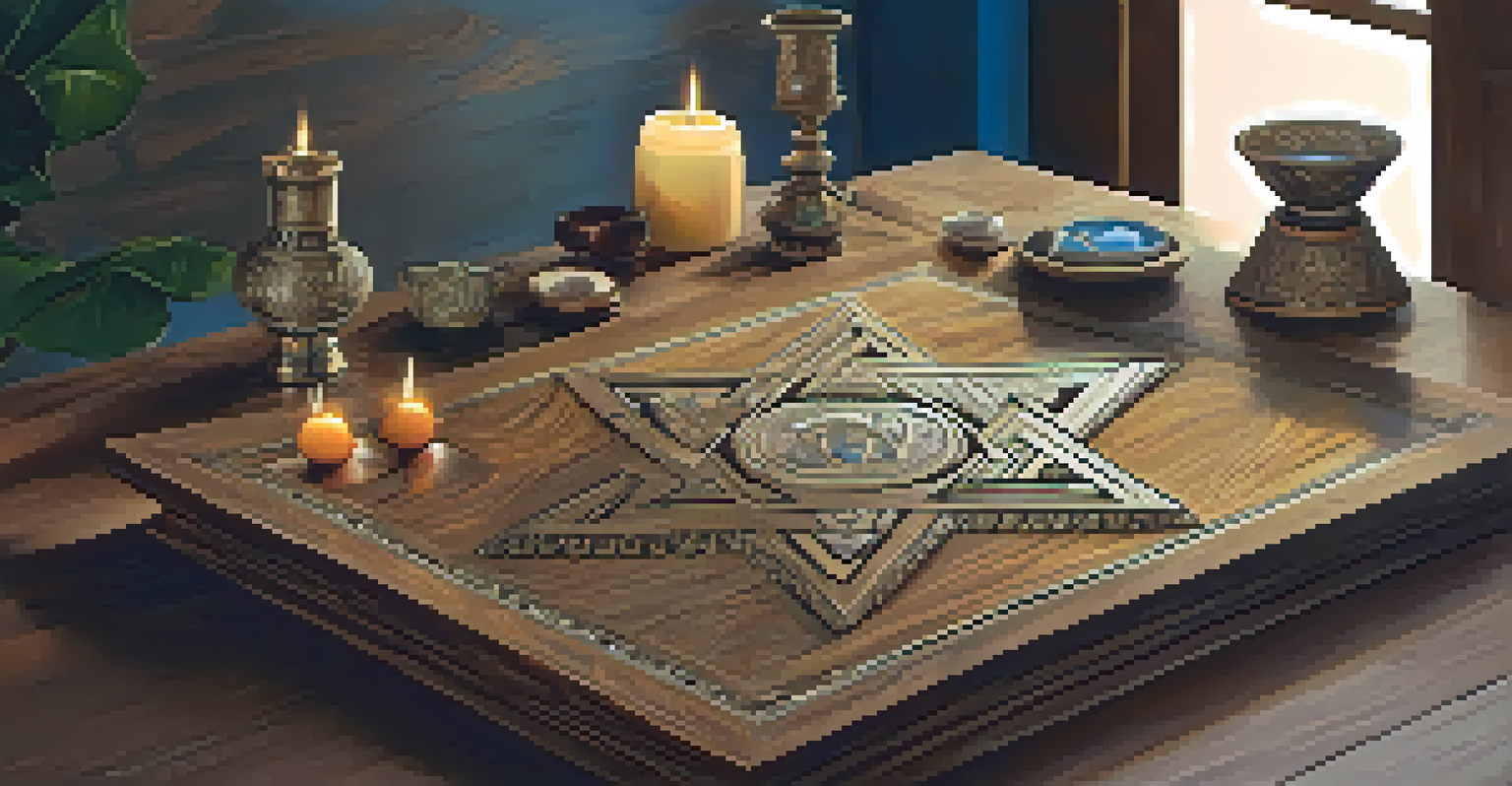The Significance of Sacred Symbols in Various Belief Systems

Understanding Sacred Symbols: A Universal Language
Sacred symbols serve as a universal language that transcends cultural barriers. They convey profound meanings and beliefs, allowing individuals to connect with the divine or the universe in a tangible way. For instance, the cross in Christianity and the Om symbol in Hinduism both represent deep spiritual truths, yet each resonates differently within its respective culture.
Symbols are the language of the spirit, and they can communicate things that words cannot express.
These symbols often act as focal points for worship and meditation, providing comfort and guidance to believers. In many traditions, they help to tell stories or relay teachings that are essential to the faith. This storytelling aspect makes the symbols not just visual representations but also carriers of history and knowledge.
Moreover, sacred symbols can evoke emotional responses, fostering a sense of community among practitioners. When individuals see or use these symbols, they may feel a shared identity and belonging, reinforcing their commitment to the beliefs they represent.
Cultural Variations: Sacred Symbols in Different Religions
Every belief system has its own unique set of sacred symbols, each carrying specific meanings and significance. For example, the Star of David is central to Judaism, symbolizing the connection between God and humanity. In contrast, the crescent moon and star are often associated with Islam, representing faith and spirituality.

These symbols can also reflect the history and evolution of the cultures they originate from. The lotus flower in Buddhism, for instance, symbolizes purity and enlightenment, emerging beautifully from muddy waters. This imagery resonates deeply with the struggles and triumphs faced by practitioners on their spiritual journeys.
Sacred Symbols Unite Cultures
Sacred symbols transcend cultural barriers, allowing individuals to connect with the divine and fostering a sense of community among practitioners.
Understanding these cultural variations enriches our appreciation of human spirituality. It highlights how different communities interpret the divine and their shared experiences through unique symbols, ultimately fostering respect and dialogue between diverse belief systems.
The Role of Symbols in Rituals and Ceremonies
Sacred symbols play a crucial role in rituals and ceremonies, serving as powerful tools to facilitate communication with the divine. For instance, in many Indigenous cultures, totems represent ancestral spirits and are integral to various rites, guiding practitioners through sacred experiences. These symbols often ground the rituals, adding layers of meaning and intention.
Every culture has its own symbols, and those symbols reflect the beliefs and values of that culture.
During ceremonies, such as weddings or initiations, symbols help mark significant transitions in life. A wedding ring, for example, symbolizes commitment and love, while a baptismal font represents purification and new beginnings. These representations help participants and onlookers grasp the importance of the event, connecting them to the broader narrative of the faith.
Furthermore, the use of symbols in rituals can evoke a sense of continuity and tradition. When people engage in these time-honored practices, they link themselves to generations past, fostering a sense of belonging and purpose within their faith community.
Sacred Symbols as Tools for Personal Reflection
Beyond communal aspects, sacred symbols can serve as powerful tools for personal reflection and growth. Many individuals use these symbols to guide their meditation or spiritual practices, allowing them to delve deeper into their beliefs. For example, a mandala can represent the universe and prompt introspection about one’s place within it.
These symbols often encourage practitioners to explore their inner selves and confront their challenges. By focusing on a sacred symbol, individuals can find clarity, purpose, and peace amidst life's chaos. This personal connection to the symbols fosters a unique journey of self-discovery and spiritual development.
Symbols Enhance Rituals and Growth
In rituals and personal practices, sacred symbols serve as powerful tools that facilitate communication with the divine and encourage self-reflection.
Additionally, as people evolve in their beliefs, their relationship with these symbols may change. What once served a specific purpose in one’s spiritual journey can transform, reflecting growth and new understandings, highlighting the dynamic nature of faith and belief.
The Impact of Sacred Symbols on Art and Culture
Sacred symbols have significantly influenced art and culture throughout history, inspiring countless works across various mediums. From ancient sculptures to modern paintings, these symbols provide artists with a canvas to explore spirituality and express their beliefs. For instance, the use of religious iconography in Renaissance art served to convey deep spiritual messages to viewers.
Moreover, sacred symbols often appear in architecture, shaping how places of worship are designed and experienced. The intricate designs of cathedrals, temples, and mosques incorporate these symbols, creating spaces that reflect the values and aesthetics of the belief systems they represent. This architectural symbolism enhances the spiritual atmosphere of these sacred sites.
By examining how sacred symbols manifest in art and culture, we gain insight into the values and priorities of different societies. These expressions not only preserve traditions but also invite dialogue and understanding across cultures, showcasing the universal quest for meaning and connection.
Contemporary Reinterpretations of Sacred Symbols
In today's world, sacred symbols are often reinterpreted and adapted to fit contemporary contexts. Many people incorporate these symbols into their daily lives, sometimes stripping away their original meanings. For instance, the use of the peace symbol has evolved from its origins in the anti-nuclear movement to a broader representation of harmony and acceptance.
This reinterpretation can spark conversations about the importance of context in understanding symbols. While some embrace these adaptations as a way to promote inclusivity, others may feel that it diminishes the original significance. This dialogue highlights the ongoing relationship between tradition and modernity, encouraging individuals to reflect on their beliefs.
Evolving Meanings in Modern Contexts
As globalization continues, sacred symbols are being reinterpreted, reflecting new meanings while sparking dialogue about tradition and modernity.
Furthermore, the blending of sacred symbols across cultures can lead to new spiritual expressions. As globalization continues to connect diverse communities, symbols may take on new meanings, fostering hybrid practices that challenge and enrich traditional beliefs.
The Future of Sacred Symbols in a Globalized World
As the world becomes increasingly interconnected, the future of sacred symbols is poised for transformation. These symbols may evolve in their meanings and representations as cultures interact and share beliefs. The rise of digital platforms allows for the rapid dissemination of ideas, potentially reshaping how sacred symbols are perceived and utilized.
In this global landscape, the challenge lies in preserving the integrity of these symbols while embracing new interpretations. Encouraging respectful dialogue about sacred symbols can help navigate the complexities of cultural exchange, fostering understanding and appreciation among diverse communities.

Ultimately, the significance of sacred symbols will continue to be a vital aspect of human spirituality. As individuals seek connection in this rapidly changing world, these symbols will remain powerful reminders of our shared quest for meaning, purpose, and belonging.